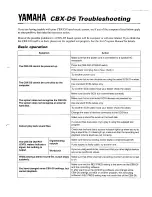
8
[AMPLIFIER SETUP AND BASS MANAGEMENT]
Many home theater receivers/processors have a feature that controls how the bass is processed and delivered to the subwoofer. It also adjusts
the amount of bass that is sent to your satellite speakers. Look carefully in your amplifier or receiver’s instruction manual for details on how
to adjust for the speaker size (sometimes called “Speaker Setup”) for your system.
When using a Dolby Digital or DTS-capable receiver/processor with the subwoofer connected to the subwoofer out on your amplifier turn the
“LOW-PASS FREQUENCY” control to the highest setting (200 Hz) on the back of your subwoofer. Set the subwoofer crossover setting in the
speaker setup section of the amplifier setup menu to 150 HZ (or the next highest setting) and set the Satellites and Center channels to “small”.
If you are NOT using the receiver’s internal processor for subwoofer control then turn the “CROSSOVER FREQUENCY” control on the
subwoofer to the 3 o’clock (150 Hz) setting.
[CARING FOR YOUR PHASE TECHNOLOGY SPEAKER]
All Phase Technology speakers are finished with a high degree of craftsmanship in either hand polished paint or vinyl laminates. We recommend
using a lint-free rag with a small amount of glass cleaner to maintain the long-lasting beauty of the finish. Avoid products containing silicones,
oils, oil derivatives, or solvents. Enclosures finished in vinyl laminates may be cleaned with a damp cloth as necessary.
[MAINTENANCE AND SERVICE]
Because of Phase Technology’s uncompromising quality control programs, it’s unlikely that your speakers will ever need service if connected
and used as outlined in this Owners’ Manual. In the unlikely event that a problem does occur, please contact your Phase Technology dealer.
Your dealer has the necessary factory-authorized parts and trained technicians to quickly restore your speaker to its original performance
specifications.
[TROUBLESHOOTING]
NO SOUND
1.
Verify that all components are plugged in and turned on.
2.
Check all speaker wires and cables for loose connections.
3.
Check to see if you have selected the proper source on your amplifier.
VOICES DO NOT APPEAR TO COME FROM BETWEEN THE SPEAKERS / BASS RESPONSE IS WEAK
1.
Verify that all speaker connections from the amplifier to the speakers are running PLUS+ to PLUS+ and MINUS- to MINUS-.
2.
Check to see if there are any furnishings or plants that may be blocking the output of a speaker. Make sure nothing is directly in front
of that speaker.
1. Power ON/Auto/OFF:
This switch, when left in the “Auto” position,
automatically activates the subwoofer when an audio signal is detected and
shuts the subwoofer off after approximately ten (10) minutes of silence.
2. Subwoofer Level Control:
Adjusts the volume of bass energy allowing you to
customize overall tonal balance to your individual room acoustics and personal
taste.
3. Crossover Frequency Control:
This adjustment varies the point at which the
subwoofer takes over the task of creating low bass frequencies from the rest
of the audio signal permitting additional fine tuning of the total system. A little
experimentation with this control will allow you to match the performance of
the subwoofer to the rest of your speakers resulting in extraordinary, accurate,
deep bass response. This control should be turned to its highest setting when
the sub is connected through the Subwoofer out on your receiver.
4. Phase Control:
This adjustment matches the phase - the in and out
movement of speaker cones - to that of your main speakers. Adjust this control
by listening to music with bass content. The setting is correct when the bass
sounds the fullest.
5. High Level Input and Output:
Used for direct speaker connections from the
left and right front speaker outputs when a low-level subwoofer output is not
available.
6. Low Level Input:
Used from pre-out or Subwoofer-out.
[SUBWOOFER AMPLIFIER PANEL]




























